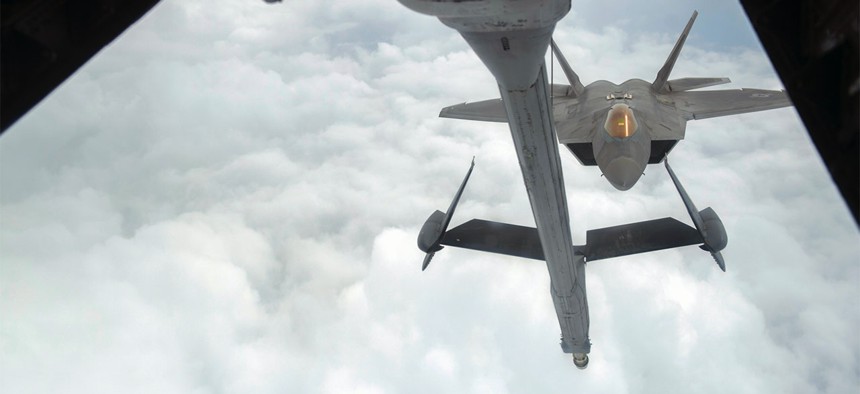
A U.S. Air Force F-22 Raptor approaches a U.S. Air Force KC-10 Extender from the 908th Expeditionary Air Refueling Squadron before aerial refueling during a Combined Joint Task Force - Operation Inherent Resolve mission Feb. 12, 2017. Staff Sgt. Matthew B. Fredericks / Air Force
Can U.S. Warplanes Evade Russian Air Defenses? We May Soon Find Out in Syria
If things go south, high-end American fighters may take on top-of-the-line Russian anti-aircraft missiles.
For years, the U.S. military has been fretting about the return of conflicts in which air defenses play a big role. If tensions escalate in Syria, high-end American fighter jets might face off against Russia’s top-of-the-line anti-aircraft missiles — and both sides will quickly learn who has the edge.
Russia began moving its high-end, ready-for-World-War-III air defense equipment into Syria early on in the conflict. In November 2015, a Turkish F-16 downed a Russian Su-24M near the Turkish border. Russia deployed an S-400 anti-aircraft radar and missile battery into the country. It’s basically a truck with a big radar several more trucks with missiles capable of detecting and intercepting air targets at a range of 400 km, at least according to Russian descriptions of January 2015 intercept tests.
In October 2016, Moscow sent an S-300 (more precisely, an Antey 2500 S-300VM) to a Syrian naval base in Tartus.
“The Syrian Arab Republic received an S-300 anti-aircraft missile system. This system is designed to ensure the safety of the naval base in Tartus and ships located in the coastal area” Russian Defense Ministry spokesman Igor Konashenkov told Russian media . He declared that the system was “purely defensive.”
Russia says the S-300 could bring down Tomahawk missiles of the sort that the United States used in the strike and even “stealthy aircraft.” But that's never happened and the Russians and the U.S. have agreed, at least for now, not to target one another. Here’s some Russian military propaganda featuring an imagined confrontation between an unnamed, but very American-looking adversary:
How scary are the S-300 and the S-400 really? Defense One reached out to two subject matter experts through the Association of Old Crows.
“The systems are very capable in their intended role,” they said and declined to comment further because of the high sensitivity of the topic since Thursday.
Russia has also sent a less advanced SA-22 anti-aircraft radar and missile system. There may be more to come. On Friday, Russia said it would bolster Syrian air defenses, but left unsaid just how.
U.S. military commanders told reporters at the Pentagon on Friday that the U.S. strikes didn’t even fully destroy the “known air defenses at this airfield.” But they did hit a Russian-made (but Syrian-operated) air defense system with a radar and missile battery.
“The Russians do have very advanced air defense capabilities in the country. We did not see any reaction from Russian air defense capabilities,” the commanders said.
In fact, the Russians have not really had to use their complex anti-aircraft capabilities at all in Syria. Why? Neither ISIS nor the rebels have a real air force.
The United States called the Russians before to the strike but the question of whether the Russians would use their missiles against the Tomahawks did not come up. “We didn’t offer, [to not strike Russian forces.] We didn’t ask [them to not use anti-aircraft missiles against U.S. targets],” said commanders.
So long as the Russians and the United States keep up daily conversations , the status quo will endure, hopefully, and the two sides can continue shooting around, rather than at one another. But if those the two militaries do face off, the U.S. may have to resort to stealth aircraft such as the F-22 Raptor to deliver strikes. It may also use advanced electronic warfare techniques to jam enemy radar, or they could deploy the military’s main electronic warfare fighter, the Boeing E-18 Growler, armed with wing-mounted jammer pods.
But as Tyler Rogoway wisely points out , “brochure comparisons’ of systems [such as the Growler] are nearly useless for such complex military topics. In real life, the Growler does not take on the S-400 alone, and vice-versa.”
If the United States and Russia were to begin shooting at one another, operators would be using radars, satellites, and signals intelligence gathered via other means including cyber operations to target weapons. The other side would use a variety of jammers, hacking techniques, to avoid getting hit while conducting operations. There would be no straight one-on-one matchups.
Rather, a lot of expensive stuff would go to war.
Syria would become a very small version of what military leaders call an anti-access, area denial environment, or A2/AD. It’s something the United States has not seen as part of the decades-old counter-terrorism fight. An A2/AD war is one in which a real, modern, and well-armed military fights to keep the U.S. away from a strategic objective and would mean a war of exponentially greater scale.
For decades, U.S. military forces have operated in a so-called permissive air environment, one in which the Air Force didn’t have to worry nearly as much about an enemy with real air defenses. In January , America’s top air commander, Air Force chief of staff David Goldfein, called the situation in Syria “highly complex.”
“As Russia changes its footprint there, it just adds to the complexity,” he said.
Depending on Russian actions and U.S. counter responses, the complexity of the air environment over Syria in January may look quant in retrospect.
Marcus Weisgerber and Caroline Houck contributed to this report.







